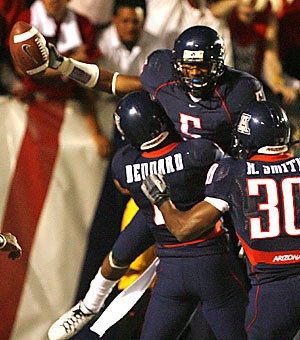One of the nation’s top tight ends cannot be found atop any of the statistical leader boards.
On the list of eight semifinalists for the Mackey Award – given to the nation’s top tight end – his name is suspiciously absent as well.
But according to the coaches and defenses of the Pacific 10 Conference, Arizona tight end Rob Gronkowski is in plain sight.
After last weekend’s loss to Oregon, the Ducks’ coaches spoke about the difficulty in covering the 6-foot-6, 260-pound receiving threat who tore them apart for 143 yards and a score on 12 catches.
Similar focus was paid to the sophomore by USC head coach Pete Carroll, who said Gronkowski is “”a tremendous player and we had to do everything we could to shut him down.””
So when his own coaches and teammates are asked about him, there’s no question about the impact he makes, even if all of his efforts don’t appear on the stat sheets.
“”He’s as good as I’ve ever seen,”” said offensive coordinator Sonny Dykes of Gronkowski. “”I’ve seen other guys that are probably better receivers, but they lack his power.
“”I’ve never seen a guy as big as he is who’s as effective at the point of attack blocking-wise and who has the ability to be a wide receiver. I’ve never come across a guy like that. … I’d like to see eight guys better than him.””
One reason for Gronkowski’s absence from many statistical leader boards is due to his three-game absence at the start the year: He was forced to the sidelines due to a case of mononucleosis and strep throat.
Upon his return, however, the sophomore appeared to have gone back to a similar form as last season, in which he hauled in an average of more than 18 yards per catch along with six scores.
This season, Gronkowski has already eclipsed many of his marks from last season in just seven games, as he already has eight touchdowns and has racked up 500 receiving yards.
Arizona quarterback Willie Tuitama said having a target with the ability of the big tight end makes his own position that much easier.
“”I just try to put the ball somewhere where he can make a play on it,”” Tuitama said. “”There were a couple times (against Oregon) where he was manned up tight – and when you look at it he’s 6-6. You just have to throw it up a little bit and let him go get it. We just use his size to his advantage.””
Gronkowski’s size has made him quite the dual threat with his ability to make big plays through the air as well as open holes for the Wildcats’ running attack.
Recently, the Arizona coaching staff has put their focus on Gronkowski’s blocking instead of
his catching.
Though he likes to think of himself as a receiver first, Gronkowski said there are parts of being a pseudo-offensive lineman that he finds enjoyable.
“”I like blocking, I think I’m pretty good, especially for a tight end,”” Gronkowski said. “”It’s not fun doing it every single play ððð- going out for a pass is fun too. But if you get a good block you feel pretty good about it.””
His impact has not been minimal on Arizona’s front line as his presence has contributed to the Wildcats’ strong ground game, one that is ranked fourth in the Pac-10 with an average of more than 170 yards per game.
Gronkowski’s efforts up front have indeed impressed Dykes and other Arizona coaches, but that has not taken away from his undeniable threat as a pass-catcher.
Due to his large stature, many defensive backs find it difficult to cover him, much less take him down by themselves.
Many Arizona fans still remember last season when Gronkowski bulldozed several Washington State defenders after making a catch down the middle before bolting to the endzone.
Similar efforts have been prevalent throughout this season, though the sophomore credits his power to his work ethic. The Amherst, N.Y. native said he doesn’t “”really have moves or anything. I usually just keep running until I fall.””
After last weekend’s offensive explosion from Gronkowski, Oregon State will likely make the receiving-side of the sophomore a focal point defensively, much like previous conference opponents have done.
However, Dykes says that will not make much difference in game-planning. It will be just more of the usual for his offensive weapon.
“”We’re just going to try to get him the ball and see how they play him,”” Dykes said. “”We may move him around and just be creative to try and get him isolated. But we’ll find ways to get him the ball.””









